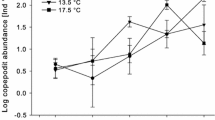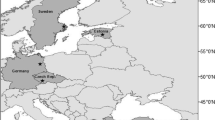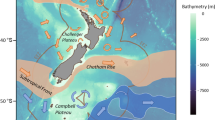Abstract
The body size of zooplankton has many substantive effects on the function of aquatic food webs. A variety of factors may affect size, and earlier studies indicate that water temperature may be a particularly important variable. Here we tested the hypothesis that the body size of cladocerans, calanoids, and cyclopoids declines with increasing water temperature, a response documented in an earlier study that considered only cladoceran zooplankton. We tested the hypothesis by comparing body size data that were available from prior studies of lakes ranging from 6 to 74o latitude and encompassing a temperature range of 2–30°C. Cladoceran body size declined with temperature, in a marginally significant manner (P = 0.10). For cyclopoids, the decline was more significant (P = 0.05). In both cases, there was considerably more variation around the regression lines than previously observed; suggesting that other variables such as fish predation played a role in affecting size. Calanoid body size was unrelated to temperature. In contrast with cladocerans and cyclopoids, perhaps calanoid body size is not metabolically constrained by temperature or is differently affected by changes in fish predation occurring with increasing temperature. The unexpected result for calanoids requires further investigation.


Similar content being viewed by others
References
Adrian, R. & T. Frost, 1993. Omnivory in cyclopoid copepods: comparisons of algae and invertebrates as food for three, differently sized species. Journal of Plankton Research 15: 643–658.
Angilletta, M. J. & A. E. Dunham, 2003. The temperature-size rule in ectotherms: simple evolutionary explanations may not be general. The American Naturalist 162: 332–342.
Ashton, K. G., 2001. Are ecological and evolutionary rules being dismissed prematurely? Diversity and Distributions 7: 289–295.
Atkinson, D., 1994. Temperature and organism size – a biological law for ectotherms? Advances in Ecological Research 25: 1–58.
Brooks, J. L. & S. I. Dodson, 1965. Predation, body size, and composition of plankton. Science 150: 28–35.
Carpenter, S. R. & J. F. Kitchell, 1988. Consumer control of lake productivity. Bioscience 38: 764–769.
Crisman, T. L., 1992. Natural lakes of the southeastern United States: origin, structure and function. In Hackney, C. T., S. M. Adams & W. A. Martin (eds), Biodiversity of the South-Eastern United States: Aquatic Communities. Wiley, New York: 475–538.
Daufresne, M., K. Lengfellner & U. Sommer, 2009. Global warming benefits the small in aquatic ecosystems. Proceedings of the National Academy of Sciences 106: 12788–12793.
Drenner, R. W. & S. R. McComas, 1984. The role of zooplankter escape ability and fish size selectivity in the selective feeding and impact of planktivorous fish. In Taub, F. B. (ed.), Lakes and Reservoirs, Ecosystems of the World. Elsevier, Amsterdam: 587–593.
Dumont, H. J., I. Van de Velde & S. Dumont, 1975. The dry weight estimate on a selection of Cladocera, Copepoda and Rotifera from the plankton, periphyton and benthos of continental waters. Oecologia 19: 75–97.
Escribano, R. & I. A. McLaren, 1992. Influence of food and temperature on lengths and weights of two marine copepods. Journal of Experimental Marine Biology and Ecology 19: 77–88.
Fernando, C. H., 1994. Zooplankton, fish and fisheries in tropical freshwaters. Hydrobiologia 272: 105–123.
Geiling, W. T. & R. S. Campbell, 1972. The effect of temperature on the development rate of the major life stages of Diaptomus pallidus Herrick. Limnology and Oceanography 17: 304–307.
Gélinas, M., B. Pinel-Alloul & M. Ślusarczyk, 2007. Formation of morphological defences in response to YOY perch and invertebrate predation in two Daphnia species coexisting in a mesotrophic lake. Hydrobiologia 594: 175–185.
Giguere, L. A., J. F. St Pierre, B. Bernier, A. Vezina & J. G. Rondeau, 2011. Can we estimate the true weight of zooplankton samples after chemical preservation? Canadian Journal of Fisheries and Aquatic Sciences 46: 522–527.
Gillooly, J. F., 2000. Effect of body size and temperature on generation time in zooplankton. Journal of Plankton Research 22: 241–251.
Gillooly, J. F. & S. I. Dodson, 2000. Latitudinal patterns in the size distribution and seasonal dynamics of new world, freshwater cladocerans. Limnology and Oceanography 45: 22–30.
Hart, R. C. & E. A. Bychek, 2011. Body size in freshwater planktonic crustaceans: an overview of extrinsic determinants and modifying influences of biotic interactions. Hydrobiologia 668: 61–108.
Havens, K. E., T. L. East, J. Marcus, P. Essex, B. Bolan, S. Raymond & J. R. Beaver, 1996. Dynamics of the exotic Daphnia lumholtzii and native macro-zooplankton in a subtropical chain-of-lakes in Florida, USA. Freshwater Biology 45: 21–32.
Hooff, R. C. & W. T. Peterson, 2006. Copepod biodiversity as an indicator of changes in ocean and climate conditions of the northern California current ecosystem. Limnology and Oceanography 51: 2607–2620.
Iglesias, C., N. Mazzeo, M. Meerhoff, G. Lacerot, J. M. Clemente, F. Scasso, C. Kruk, G. Goyenola, J. García-Alonso, S. L. Amsinck, J. C. Paggi, S. J. de Paggi & E. Jeppesen, 2011. High predation is of key importance for dominance of small-bodied zooplankton in warm shallow lakes: evidence from lakes, fish exclosures and surface sediments. Hydrobiologia 667: 133–147.
Jeppesen, E., T. L. Lauridsen, S. F. Mitchell & C. W. Burns, 1997. Do planktivorous fish structure the zooplankton communities in New Zealand lakes? New Zealand Journal of Marine and Freshwater Research 31: 163–173.
Jeppesen, E., J. P. Jensen, M. Söndergaard, T. Lauridsen & F. Landkildehus, 2000. Trophic structure, species richness and biodiversity in Danish lakes: changes along a phosphorus gradient. Freshwater Biology 45: 201–213.
Jeppesen, E., K. Christoffersen, F. Landkilehus, T. Lauridsen, S. L. Amsinck, F. Riget & M. Söndergaard, 2001. Fish and crustaceans in northeast Greenland lakes with special emphasis on interactions between Arctic charr (Salvelinus alpinus), Lepidurus arcticus and benthic chydorids. Hydrobiologia 442: 329–337.
Kainz, M., M. T. Arts & A. Mazumder, 2004. Essential fatty acids in the planktonic food web and their ecological role for higher trophic levels. Limnology and Oceanography 49: 1784–1793.
Lee, R. F., W. Hagen & G. Kattner, 2006. Lipid storage in marine zooplankton. Marine Ecology Progress Series 307: 273–306.
Lin, Y. K., A. R. Sastri, G. C. Gong & C. H. Hsieh, 2013. Copepod community growth rates in relation to body size, temperature, and food availability in the East China Sea: a test of metabolic theory of ecology. Biogeosciences 10: 1877–1892.
Lonsdale, D. J. & J. S. Levinton, 1985. Latitudinal differentiation in copepod growth: an adaptation to temperature. Ecology 66: 1397–1407.
Mazumder, A., 1994a. Phosphorus–chlorophyll relationships under contrasting herbivory and thermal stratification: predictions and patterns. Canadian Journal of Fisheries and Aquatic Sciences 51: 390–400.
Mazumder, A., 1994b. Phosphorus–chlorophyll relationships under contrasting zooplankton community structure: potential mechanisms. Canadian Journal of Fisheries and Aquatic Sciences 51: 401–407.
McCauley, E., 1984. The estimation of the abundance and biomass of zooplankton in samples. In Downing, J. A. & F. H. Rigler (eds), A Manual for the Assessment of Secondary Productivity in Fresh Waters. Blackwell Scientific, Oxford: 228–265.
Meerhoff, M., F. Teixeira-de Mello, C. Kruk, C. Alonso, I. Gonzalez Bergonzoni, P. J. Pacheco, G. Lacerot, A. Matias, M. Beklioglu, S. B. Balmana, G. Goyenola, C. Iglesias, N. Mazzeo, S. Kosten & E. Jeppesen, 2012. Environmental warming in shallow lakes: a review of potential changes in community structure as evidenced from space-for-time substitution approaches. Advances in Ecological Research 46: 259–349.
Moore, M. V., C. F. Folt & R. S. Stemberger, 1996. Consequences of elevated temperatures for zooplankton assemblages in temperate lakes. Archiv für Hydrobiologie 135: 289–319.
Pinto-Coelho, R., B. Pinel-Alloul, G. Methot & K. E. Havens, 2005. Crustacean zooplankton in lakes and reservoirs of temperate and tropical regions: variation with trophic status. Canadian Journal of Fisheries and Aquatic Sciences 62: 348–361.
Richman, S. & S. I. Dodson, 1983. The effect of food quality on feeding and respiration by Daphnia and Diaptomus. Limnology and Oceanography 28: 948–956.
Twombly, S. & N. Tisch, 2000. Body size regulation in copepod crustaceans. Oecologia 122: 318–326.
Vijverberg, J., E. Dejen, A. Getahun & L. A. J. Nagelkerke, 2014. Zooplankton, fish communities and the role of planktivory in nine Ethiopian lakes. Hydrobiologia 722: 45–60.
Zaret, T. M., 1980. Predation and Freshwater Communities. Yale University Press, New Haven, CT.
Acknowledgments
The authors are grateful to the many field and laboratory support staff who collected and analyzed zooplankton in the study regions. Without their support this paper would not have been possible. The data collection in Florida was supported financially by the South Florida Water Management District. The groups from Aarhus University and METU were supported by the MARS project (Managing Aquatic ecosystems and water Resources under multiple Stress) funded under the 7th EU Framework Programme, Theme 6 (Environment including Climate Change), Contract No.: 603378 (http://www.mars-project.eu). The data collection in Turkey was supported by TUBİTAK-ÇAYDAG (Projects 105Y332 and 110Y12) The Greenland studies was supported by the Research Council for Nature and Universe, Greenland Climate Research Centre and the Danish Agency of the Environment. The data collection in Ethiopia was supported by the National Science Foundation (NWO) project R83-206 and by the Schure-Beijerinck-Popping Fund of the Royal Netherlands Academy of Arts and Sciences (KNAW) project SBP/JK/2004-14. The Canadian studies were supported by the National Science and Engineering Research Council and the Ontario Ministry of Natural Resources. Data collection in Brazil was supported by CNPq (Proc. 521.513/93-6) and FAPEMIG (CBS 1897/96) grants. The work in Florida was done under CRIS Project FLA-FRE-005152 and was supported by the National Sea Grant College Program of the United States Department of Commerce, National Oceanic and Administration, under NOAA Grant NA06OAR-4170014. The authors thank Roger Bachmann for pre-reviewing this paper and providing many valuable comments.
Author information
Authors and Affiliations
Corresponding author
Additional information
Handling editor: John Havel
Electronic supplementary material
Below is the link to the electronic supplementary material.
Rights and permissions
About this article
Cite this article
Havens, K.E., Pinto-Coelho, R.M., Beklioğlu, M. et al. Temperature effects on body size of freshwater crustacean zooplankton from Greenland to the tropics. Hydrobiologia 743, 27–35 (2015). https://doi.org/10.1007/s10750-014-2000-8
Received:
Revised:
Accepted:
Published:
Issue Date:
DOI: https://doi.org/10.1007/s10750-014-2000-8




